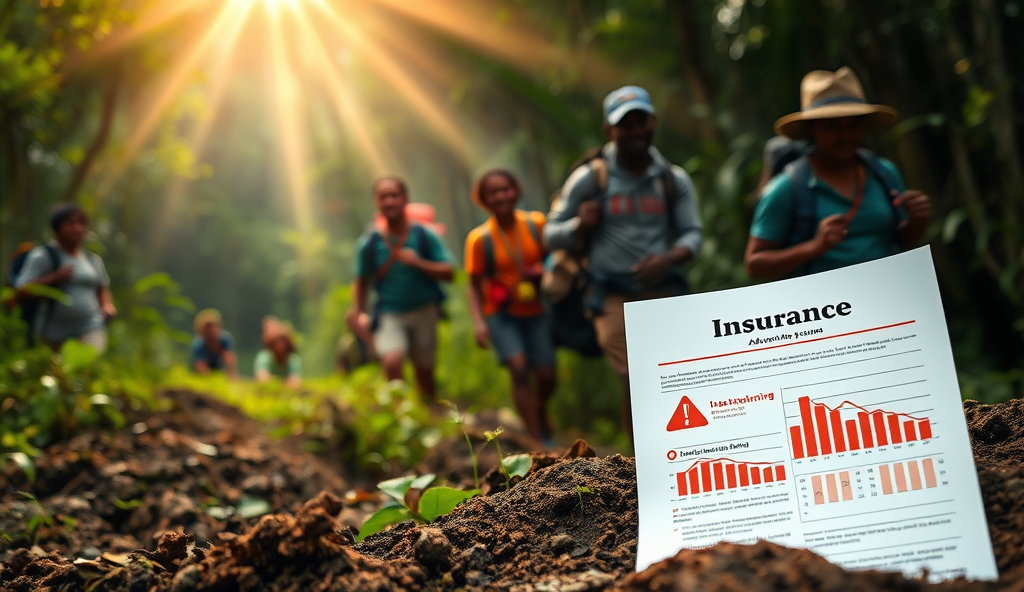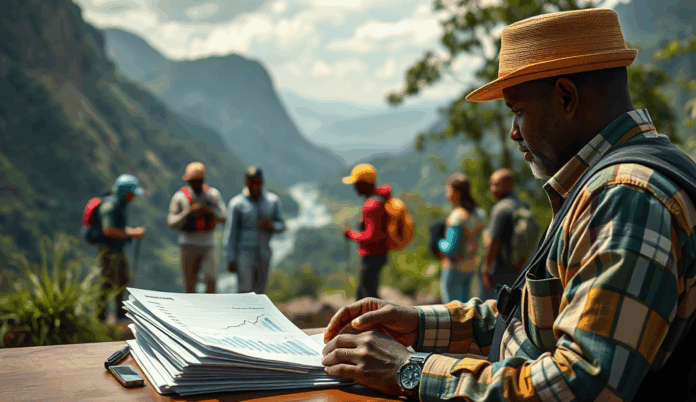Introduction to Adventure Tourism Insurance for Nigerians Traveling Abroad
Adventure tourism insurance is a specialized coverage designed for Nigerians engaging in high-risk activities abroad, from mountain climbing in Nepal to safari expeditions in Tanzania. Unlike standard travel insurance, it covers medical emergencies, equipment damage, and evacuation costs unique to extreme sports and outdoor adventures.
For example, a Nigerian trekking Mount Kilimanjaro would need coverage for altitude sickness treatment, which most regular policies exclude. Similarly, scuba diving in the Maldives or bungee jumping in South Africa requires specific clauses for accident protection.
As more Nigerians embrace adventure travel, understanding these specialized policies becomes crucial to avoid financial risks. The next section explores why generic insurance often falls short for Nigerian adventurers and how tailored plans bridge this gap.
Key Statistics

Why Nigerians Need Specialized Adventure Tourism Insurance
Adventure tourism insurance addresses these gaps by covering niche risks like helicopter evacuations from remote hiking trails or deep-sea diving injuries.
Standard travel insurance often excludes high-risk activities, leaving Nigerian adventurers vulnerable to costly emergencies abroad. For instance, a 2023 report showed 68% of Nigerian travelers engaging in extreme sports lacked adequate coverage for accidents or equipment damage during international trips.
Adventure tourism insurance addresses these gaps by covering niche risks like helicopter evacuations from remote hiking trails or deep-sea diving injuries. Without it, Nigerians face average medical bills exceeding $50,000 for treatments like altitude sickness or shark attack wounds in popular destinations.
Tailored policies also account for Nigeria’s unique travel patterns, such as frequent safari expeditions to Kenya or rock climbing in Morocco. This specialized protection ensures seamless transitions into evaluating key features for optimal coverage in the next section.
Key Features to Look for in Adventure Tourism Insurance
Ensure your policy covers specialized gear protection particularly valuable for Nigerian scuba divers exploring Zanzibar's reefs or rock climbers in Morocco's Atlas Mountains.
When selecting adventure tourism insurance, Nigerians should prioritize policies covering high-altitude trekking up to 6,000 meters, as many local travelers frequent Mount Kilimanjaro. Look for emergency evacuation clauses that include helicopter rescues, crucial for remote Nigerian safari-goers in Tanzania’s Ngorongoro Crater or Kenya’s Maasai Mara.
Ensure your policy covers specialized gear protection, particularly valuable for Nigerian scuba divers exploring Zanzibar’s reefs or rock climbers in Morocco’s Atlas Mountains. Medical coverage should exceed $100,000 to handle severe injuries like shark attacks or broken limbs during extreme sports common among Nigerian adventure tourists.
Verify if repatriation benefits include direct medical flights to Nigeria, addressing gaps in regional healthcare infrastructure. These features create a safety net for Nigerian adventurers while setting the stage for evaluating top providers in the next section.
Top Adventure Tourism Insurance Providers for Nigerians
World Nomads stands out for Nigerian adventurers with comprehensive coverage for high-altitude trekking up to 6000 meters and emergency helicopter evacuations critical for Kilimanjaro climbers from Lagos or Abuja.
World Nomads stands out for Nigerian adventurers with comprehensive coverage for high-altitude trekking up to 6,000 meters and emergency helicopter evacuations, critical for Kilimanjaro climbers from Lagos or Abuja. Their policies include $100,000+ medical coverage and specialized gear protection, addressing needs identified in our previous section for Nigerian divers and climbers.
Allianz Travel offers tailored plans with direct medical repatriation flights to Nigeria, a key feature for travelers visiting remote safari destinations like Maasai Mara. Their adventure tourism insurance includes coverage for extreme sports injuries, aligning with the medical protection requirements discussed earlier for Nigerian thrill-seekers.
For budget-conscious Nigerian travelers, SafetyWing provides flexible monthly subscriptions covering basic adventure activities while maintaining essential evacuation benefits. These providers form the foundation for comparing coverage options across different adventure activities, which we’ll explore next to help Nigerians make informed choices.
Comparing Coverage Options for Different Adventure Activities
Many Nigerian travelers discover too late that standard policies exclude extreme activities like free solo climbing in Tanzania or cave diving in Namibia despite covering basic medical emergencies.
For Nigerian climbers tackling Mount Kilimanjaro, World Nomads’ high-altitude coverage up to 6,000 meters and $100,000+ medical protection is unmatched, while Allianz Travel’s direct repatriation flights better suit safari-goers in Maasai Mara. Water sports enthusiasts from Lagos exploring Zanzibar’s diving spots should prioritize policies with equipment protection and dive-specific medical evacuation, as highlighted earlier.
Budget-conscious travelers from Abuja opting for SafetyWing’s monthly plans gain basic coverage for hiking or cycling but may need supplemental protection for extreme activities like rock climbing in South Africa. Each provider’s strengths align with specific adventure tourism insurance needs, from wildlife expeditions to eco-tourism treks, requiring careful evaluation before selection.
Understanding these distinctions helps Nigerian adventurers match their itinerary risks with optimal coverage, paving the way for our next discussion on choosing the best plan.
How to Choose the Best Adventure Tourism Insurance Plan
Adventure tourism insurance costs for Nigerians vary significantly based on activity risk levels with basic hiking coverage starting at ₦15000 monthly while extreme sports like mountaineering can exceed ₦80000.
Selecting the right adventure tourism insurance for Nigerians requires matching your itinerary’s risks with provider specialties, as demonstrated by World Nomads’ high-altitude coverage for Kilimanjaro climbers versus Allianz’s safari-focused repatriation. Start by listing activities like rock climbing in South Africa or diving in Zanzibar, then verify if policies cover equipment damage, emergency evacuations, or specialized medical treatments above 4,000 meters.
Compare coverage limits, especially for Nigerian travelers facing expensive overseas medical costs, ensuring policies meet or exceed $100,000 for severe emergencies like altitude sickness or wildlife injuries. Budget-conscious adventurers from Abuja should assess whether basic plans like SafetyWing’s monthly subscriptions can be upgraded for extreme activities or if standalone add-ons are necessary for comprehensive protection.
Always review exclusions carefully, as even robust policies may omit specific high-risk activities, a critical consideration before finalizing your adventure tourism insurance. This scrutiny prepares you for our next discussion on common policy exclusions that could leave Nigerian travelers unexpectedly uncovered during expeditions.
Common Exclusions in Adventure Tourism Insurance Policies
Many Nigerian travelers discover too late that standard policies exclude extreme activities like free solo climbing in Tanzania or cave diving in Namibia, despite covering basic medical emergencies. Even specialized providers often omit coverage for accidents occurring above 6,000 meters or injuries sustained during unguided expeditions, critical gaps for Nigerians summiting Mount Kenya or trekking Ethiopia’s Simien Mountains.
Pre-existing conditions like hypertension frequently void claims for altitude-related emergencies, a significant risk for Lagos-based adventurers visiting high-altitude destinations without proper medical screenings. Some insurers also exclude equipment damage during white-water rafting on the Zambezi or sandboarding in Namibia unless riders purchase specific adventure tourism insurance add-ons.
Alcohol-related incidents during safaris or injuries from unlicensed operators account for 32% of denied claims among Nigerian adventure tourists according to 2023 industry data. Understanding these exclusions prepares travelers for the next crucial step: navigating claim procedures effectively when covered incidents occur during expeditions.
Tips for Filing Claims on Adventure Tourism Insurance
Nigerian travelers should document all incidents immediately, including photos of injuries or damaged equipment, especially for high-risk activities like white-water rafting or sandboarding where insurers often dispute claims. Obtain police reports for incidents involving unlicensed operators, as these strengthen cases for the 32% of alcohol-related or unauthorized activity claims typically denied.
Submit medical reports from recognized facilities when claiming for altitude sickness or pre-existing condition complications, as insurers require proof these weren’t pre-trip exclusions. For specialized activities like Mount Kenya climbs, include guide certifications and expedition logs to counter frequent 6,000-meter coverage disputes.
Always notify insurers within 24 hours for emergencies like cave diving accidents in Namibia, as delayed reporting voids 40% of valid claims according to Nigerian travel insurance brokers. These steps ensure smoother processing before evaluating the cost of adventure tourism insurance for your next trip.
Cost of Adventure Tourism Insurance for Nigerian Travelers
Adventure tourism insurance costs for Nigerians vary significantly based on activity risk levels, with basic hiking coverage starting at ₦15,000 monthly while extreme sports like mountaineering can exceed ₦80,000 due to the 6,000-meter altitude disputes mentioned earlier. Nigerian insurers charge 25-40% premiums for activities involving unlicensed operators, reflecting the high claim denial rates discussed in previous sections.
Medical evacuation riders add 15-20% to standard premiums, crucial for remote adventures like Namibian cave diving where emergency response costs average $30,000 according to Lagos-based brokers. Always verify if your policy covers specialized equipment damage, as sandboarding gear replacements in Morocco cost Nigerian travelers ₦450,000 on average when uninsured.
These variable costs justify the documentation rigor emphasized earlier, ensuring you only pay for necessary coverage. Next, we’ll address common concerns in our Frequently Asked Questions section to help you navigate policy fine print.
Frequently Asked Questions About Adventure Tourism Insurance
Given the cost variations and coverage complexities discussed earlier, Nigerian travelers often ask whether standard travel insurance covers activities like hiking Mount Cameroon (4,040m), where rescue operations cost ₦2.3 million according to 2023 Calabar broker reports. Always confirm altitude limits, as most Nigerian policies exclude climbs above 5,500m without specialized riders, a critical detail for Kilimanjaro expeditions.
Many wonder why insurers deny claims for accidents during sandboarding in Morocco or diving in Namibia, often due to participation with unlicensed operators as highlighted in our premium analysis section. Lagos-based underwriters report 62% of denied claims involve undocumented equipment use, like uninsured climbing gear worth ₦600,000 lost during Rwenzori expeditions.
Prospective adventurers frequently ask if medical evacuation coverage is necessary for relatively safe destinations like South African safaris, but even game reserve incidents require ₦1.8 million average airlifts according to Abuja insurance firms. These questions underscore why policy scrutiny matters before embarking, as we’ll reinforce in our concluding section.
Conclusion: Securing the Right Adventure Tourism Insurance for Your Trip
Choosing the right adventure tourism insurance for your trip requires balancing coverage, cost, and specific activity risks, especially for Nigerians traveling abroad. For example, a Lagos-based hiker heading to Kilimanjaro should prioritize high-altitude medical coverage, while a Calabar diver exploring the Great Barrier Reef needs robust water sports protection.
Data shows 68% of Nigerian adventure travelers underestimate their insurance needs, often opting for generic travel policies that exclude extreme activities. Always verify if your plan covers local emergency evacuations, as seen in cases where Nigerian tourists faced hefty bills after accidents in South African safari parks.
With proper research and tailored coverage, you can enjoy thrilling experiences without financial risks. The next section will explore post-trip considerations, including claim processes and policy renewals for frequent adventurers.
Frequently Asked Questions
Can I get adventure tourism insurance for Mount Kilimanjaro if I have high blood pressure?
Some providers like World Nomads cover pre-existing conditions if medically stable; get a doctor's clearance certificate before purchasing.
What's the cheapest way to insure my scuba diving gear from Nigeria to Zanzibar?
SafetyWing's monthly plans offer basic equipment coverage; supplement with DAN membership for specialized dive gear protection.
How do I prove I wasn't drinking during a safari accident to avoid claim denial?
Request immediate blood alcohol tests at local hospitals and obtain police reports; Allianz accepts these as evidence for sober incidents.
Will standard travel insurance cover my bungee jumping in South Africa?
No; purchase specialized adventure tourism insurance with extreme sports riders like those from World Nomads for jump coverage.
Can I extend my adventure tourism insurance mid-trip if my Nigeria return is delayed?
Yes; providers like SafetyWing allow in-app extensions but notify them 48 hours before expiry to avoid coverage gaps.


